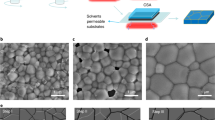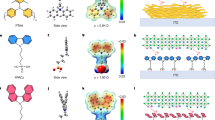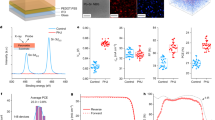Abstract
All-perovskite tandem solar cells hold the promise of surpassing the efficiency limits of single-junction solar cells1,2,3; however, until now, the best-performing all-perovskite tandem solar cells have exhibited lower certified efficiency than have single-junction perovskite solar cells4,5. A thick mixed Pb–Sn narrow-bandgap subcell is needed to achieve high photocurrent density in tandem solar cells6, yet this is challenging owing to the short carrier diffusion length within Pb–Sn perovskites. Here we develop ammonium-cation-passivated Pb–Sn perovskites with long diffusion lengths, enabling subcells that have an absorber thickness of approximately 1.2 μm. Molecular dynamics simulations indicate that widely used phenethylammonium cations are only partially adsorbed on the surface defective sites at perovskite crystallization temperatures. The passivator adsorption is predicted to be enhanced using 4-trifluoromethyl-phenylammonium (CF3-PA), which exhibits a stronger perovskite surface-passivator interaction than does phenethylammonium. By adding a small amount of CF3-PA into the precursor solution, we increase the carrier diffusion length within Pb–Sn perovskites twofold, to over 5 μm, and increase the efficiency of Pb–Sn perovskite solar cells to over 22%. We report a certified efficiency of 26.4% in all-perovskite tandem solar cells, which exceeds that of the best-performing single-junction perovskite solar cells. Encapsulated tandem devices retain more than 90% of their initial performance after 600 h of operation at the maximum power point under 1 Sun illumination in ambient conditions.
This is a preview of subscription content, access via your institution
Access options
Access Nature and 54 other Nature Portfolio journals
Get Nature+, our best-value online-access subscription
$29.99 / 30 days
cancel any time
Subscribe to this journal
Receive 51 print issues and online access
$199.00 per year
only $3.90 per issue
Buy this article
- Purchase on Springer Link
- Instant access to full article PDF
Prices may be subject to local taxes which are calculated during checkout




Similar content being viewed by others
Data availability
The data that support the findings of this study are available from the corresponding authors on reasonable request.
References
Albrecht, S. & Rech, B. Perovskite solar cells: on top of commercial photovoltaics. Nat. Energy 2, 16196 (2017).
Wang, R. et al. Prospects for metal halide perovskite-based tandem solar cells. Nat. Photonics 15, 411–425 (2021).
Jošt, M., Kegelmann, L., Korte, L. & Albrecht, S. Monolithic perovskite tandem solar cells: a review of the present status and advanced characterization methods toward 30% efficiency. Adv. Energy Mater. 10, 1904102 (2020).
Lin, R. et al. Monolithic all-perovskite tandem solar cells with 24.8% efficiency exploiting comproportionation to suppress Sn(II) oxidation in precursor ink. Nat. Energy 4, 864–873 (2019).
Min, H. et al. Perovskite solar cells with atomically coherent interlayers on SnO2 electrodes. Nature 598, 444–450 (2021).
Yang, Z. et al. Enhancing electron diffusion length in narrow-bandgap perovskites for efficient monolithic perovskite tandem solar cells. Nat. Commun. 10, 4498 (2019).
Eperon, G. E. et al. Perovskite-perovskite tandem photovoltaics with optimized band gaps. Science 354, 861–865 (2016).
Li, Z. et al. Cost analysis of perovskite tandem photovoltaics. Joule 2, 1559–1572 (2018).
Green, M. A. et al. Solar cell efficiency tables (version 58). Prog. Photovoltaics Res. Appl. 29, 657–667 (2021).
Xiao, K. et al. All-perovskite tandem solar cells with 24.2% certified efficiency and area over 1 cm2 using surface-anchoring zwitterionic antioxidant. Nat. Energy 5, 870–880 (2020).
Tong, J. et al. Carrier lifetimes of >1 μs in Sn-Pb perovskites enable efficient all-perovskite tandem solar cells. Science 364, 475–479 (2019).
Yu, Z. et al. Simplified interconnection structure based on C60/SnO2-x for all-perovskite tandem solar cells. Nat. Energy 5, 657–665 (2020).
Li, C. et al. Low-bandgap mixed tin–lead iodide perovskites with reduced methylammonium for simultaneous enhancement of solar cell efficiency and stability. Nat. Energy 5, 768–776 (2020).
Liu, H. et al. Modulated crystallization and reduced voc deficit of mixed lead–tin perovskite solar cells with antioxidant caffeic acid. ACS Energy Lett. 6, 2907–2916 (2021).
Kapil, G. et al. Tin-lead perovskite fabricated via ethylenediamine interlayer guides to the solar cell efficiency of 21.74%. Adv. Energy Mater. 11, 2101069 (2021).
Kirchartz, T. & Rau, U. What makes a good solar cell? Adv. Energy Mater. 8, 1703385 (2018).
Kirchartz, T., Bisquert, J., Mora-Sero, I. & Garcia-Belmonte, G. Classification of solar cells according to mechanisms of charge separation and charge collection. Phys. Chem. Chem. Phys. 17, 4007–4014 (2015).
Aydin, E., Bastiani, M. & Wolf, S. Defect and contact passivation for perovskite solar cells. Adv. Mater. 31, 1900428 (2019).
Ni, Z., Xu, S. & Huang, J. Resolving spatial and energetic distributions of trap states in metal halide perovskite solar cells. Science 371, 1352–1358 (2021).
Yang, Y. et al. Top and bottom surfaces limit carrier lifetime in lead iodide perovskite films. Nat. Energy 2, 16207 (2017).
Ricciarelli, D., Meggiolaro, D., Ambrosio, F. & De Angelis, F. instability of tin iodide perovskites: bulk p-doping versus surface tin oxidation. ACS Energy Lett. 5, 2787–2795 (2020).
Savill, K. J., Ulatowski, A. M. & Herz, L. M. Optoelectronic properties of tin–lead halide perovskites. ACS Energy Lett. 6, 2413–2426 (2021).
Zong, Y., Zhou, Z., Chen, M., Padture, N. P. & Zhou, Y. Lewis‐adduct mediated grain‐boundary functionalization for efficient ideal‐bandgap perovskite solar cells with superior stability. Adv. Energy Mater. 8, 1800997 (2018).
Luo, D., Su, R., Zhang, W., Gong, Q. & Zhu, R. Minimizing non-radiative recombination losses in perovskite solar cells. Nat. Rev. Mater. 5, 44–60 (2020).
Gao, F., Zhao, Y., Zhang, X. & You, J. Recent progresses on defect passivation toward efficient perovskite solar cells. Adv. Energy Mater. 10, 1902650 (2019).
Chen, J. & Park, N.-G. Materials and methods for interface engineering toward stable and efficient perovskite solar cells. ACS Energy Lett. 5, 2742–2786 (2020).
Li, C. et al. Vertically aligned 2D/3D Pb–Sn perovskites with enhanced charge extraction and suppressed phase segregation for efficient printable solar cells. ACS Energy Lett. 5, 1386–1395 (2020).
Park, S. M., Abtahi, A., Boehm, A. M. & Graham, K. R. Surface ligands for methylammonium lead iodide films: surface coverage, energetics, and photovoltaic performance. ACS Energy Lett. 5, 799–806 (2020).
Wang, R. et al. Constructive molecular configurations for surface-defect passivation of perovskite photovoltaics. Science 366, 1509–1513 (2019).
Wei, M. et al. Combining efficiency and stability in mixed tin–lead perovskite solar cells by capping grains with an ultrathin 2D layer. Adv. Mater. 32, 1907058 (2020).
Chen, B., Rudd, P. N., Yang, S., Yuan, Y. & Huang, J. Imperfections and their passivation in halide perovskite solar cells. Chem. Soc. Rev. 48, 3842–3867 (2019).
Jiang, Q. et al. Surface passivation of perovskite film for efficient solar cells. Nat. Photonics 13, 460–466 (2019).
Abate, A. et al. Supramolecular halogen bond passivation of organic-inorganic halide perovskite solar cells. Nano Lett. 14, 3247–3254 (2014).
Walsh, A., Scanlon, D. O., Chen, S., Gong, X. G. & Wei, S. Self‐regulation mechanism for charged point defects in hybrid halide perovskites. Angew. Chemie 127, 1811–1814 (2015).
Wehrenfennig, C., Eperon, G. E., Johnston, M. B., Snaith, H. J. & Herz, L. M. High charge carrier mobilities and lifetimes in organolead trihalide perovskites. Adv. Mater. 26, 1584–1589 (2014).
Hempel, H., Hages, C. J., Eichberger, R., Repins, I. & Unold, T. Minority and majority charge carrier mobility in Cu2ZnSnSe4 revealed by terahertz spectroscopy. Sci. Rep. 8, 14476 (2018).
Al-Ashouri, A. et al. Monolithic perovskite/silicon tandem solar cell with >29% efficiency by enhanced hole extraction. Science 370, 1300–1309 (2020).
Palmstrom, A. F. et al. Enabling flexible all-perovskite tandem solar cells. Joule 3, 2193–2204 (2019).
Gao, H. et al. Thermally stable all‐perovskite tandem solar cells fully using metal oxide charge transport layers and tunnel junction. Sol. RRL 5, 2100814 (2021).
Kühne, T. D. et al. CP2K: an electronic structure and molecular dynamics software package -Quickstep: Efficient and accurate electronic structure calculations. J. Chem. Phys. 152, 194103 (2020).
Nosé, S. A unified formulation of the constant temperature molecular dynamics methods. J. Chem. Phys. 81, 511–519 (1984).
VandeVondele, J. & Hutter, J. Gaussian basis sets for accurate calculations on molecular systems in gas and condensed phases. J. Chem. Phys. 127, 114105 (2007).
Goedecker, S. & Teter, M. Separable dual-space Gaussian pseudopotentials. Phys. Rev. B 54, 1703–1710 (1996).
Kresse, G. & Furthmüller, J. Efficient iterative schemes for ab initio total-energy calculations using a plane-wave basis set. Phys. Rev. B 54, 11169–11186 (1996).
Perdew, J. P., Burke, K. & Ernzerhof, M. Generalized gradient approximation made simple. Phys. Rev. Lett. 77, 3865–3868 (1996).
Lee, K., Murray, É. D., Kong, L., Lundqvist, B. I. & Langreth, D. C. Higher-accuracy van der Waals density functional. Phys. Rev. B 82, 3–6 (2010).
Lu, T. & Chen, F. Multiwfn: a multifunctional wavefunction analyzer. J. Comput. Chem. 33, 580–592 (2012).
Han, Q. et al. Low-temperature processed inorganic hole transport layer for efficient and stable mixed Pb-Sn low-bandgap perovskite solar cells. Sci. Bull. 64, 1399–1401 (2019).
Santbergen, R. et al. GenPro4 optical model for solar cell simulation and its application to multijunction solar cells. IEEE J. Photovolt. 7, 919–926 (2017).
Acknowledgements
This work was financially supported by the National Key R&D Program of China (grant no. 2018YFB1500102), the National Natural Science Foundation of China (grant nos. 61974063 and 61921005), the Natural Science Foundation of Jiangsu Province (grant nos. BK20202008 and BK20190315), the Technology Innovation Fund of Nanjing University, Fundamental Research Funds for the Central Universities (grant nos. 0213/14380206 and 0205/14380252), the Frontiers Science Center for Critical Earth Material Cycling Fund (grant no. DLTD2109), the Program A for Outstanding PhD Candidate of Nanjing University, and the Program for Innovative Talents and Entrepreneur in Jiangsu. The work at the University of Toronto was supported by the US Department of the Navy, Office of Naval Research (grant no. N00014-20-1-2572). SciNet is funded by the Canada Foundation for Innovation under the auspices of Compute Canada. K.R.G., S.M.P. and H.R.A. acknowledge the US Department of Energy, Office of Basic Energy Sciences under grant no. DE-SC0018208 for supporting the photoelectron spectroscopy measurements.
Author information
Authors and Affiliations
Contributions
H.T. conceived and directed the overall project. R.L. and Y.W. fabricated all the devices and conducted the characterization. Jian X. carried out the DFT simulation. M.W. performed Tof-SIMS, PL and PL-decay characterization. Z.Q. and C.Z. performed the terahertz measurements and analysis. Z.L. and G.C. carried out the grazing-incidence wide-angle X-ray scattering measurements. J.W., Z.L., K.X., B.C., Jun X., J.Z. and L.L. carried out device fabrication and materials characterization. S.M.P., H.R.A. and K.R.G. performed angle-dependent XPS characterization and analysis. E.H.S. and H.T. supervised the project and assisted in data analysis. R.L., M.W., Jian X., E.H.S. and H.T. wrote the manuscript. All authors discussed the results and commented on the paper.
Corresponding authors
Ethics declarations
Competing interests
The authors declare no competing interests.
Peer review
Peer review information
Nature thanks the anonymous reviewers for their contribution to the peer review of this work.
Additional information
Publisher’s note Springer Nature remains neutral with regard to jurisdictional claims in published maps and institutional affiliations.
Extended data figures and tables
Extended Data Fig. 1 Optical simulation of all-perovskite tandem solar cells.
The implied photocurrent density (Jsc) of tandems was calculated as function of wide-bandgap and narrow-bandgap perovskite layer thicknesses.
Extended Data Fig. 2 PCEs of mixed Pb-Sn perovskite solar cells with various concentrations of passivating agents.
a, PEA; b, PA; c, CF3-PA. The absorber layer thickness is ~1,200 nm.
Extended Data Fig. 3 Performance of control and CF3-PA mixed Pb-Sn perovskite solar cells with various absorber thicknesses.
For regular thinner Pb-Sn perovskite solar cells (thicknesses of 750 and 900 nm), the diffusion lengths are sufficiently long to ensure charge transport within devices. This agrees with the finding that no obvious improvement was observed in regular thinner devices after we added the CF3-PA passivating agent. The abrupt drop in performance at the thickness of 1.45 μm comes because the precursor solution fails to form high-quality films, a result of finite solubility of metal halides in DMF/DMSO solvent.
Extended Data Fig. 4 Performance of champion mixed Pb-Sn perovskite solar cells.
a, EQE spectra of champion control and CF3-PA mixed Pb-Sn solar cells. The EQE values of CF3-PA device are substantially higher than those of previous works at wavelengths above 800 nm, mainly due to the use of thicker absorber while maintaining sufficient carrier transport. It is noted that such a high Jsc value is obtained herein together with high Voc and FF even when using a 1,200 nm absorber. b, Reverse and forward J-V curves of the champion CF3-PA mixed Pb-Sn solar cell. c, The steady-state PCE of the champion CF3-PA device.
Extended Data Fig. 5 Characterization of control and CF3-PA mixed Pb-Sn perovskite films.
a–b, Cross-sectional SEM images of 1200-nm-thick (a) control and (b) CF3-PA mixed Pb-Sn perovskite solar cells. c, The F 1s XPS spectra of the control and CF3-PA perovskite films. d, TOF-SIMS spectra of mixed Pb-Sn perovskite film with CF3-PA additive. The additive is accumulated on the top perovskite surface and at the perovskite/HTL interface.
Extended Data Fig. 6 Schematic of angle-dependent XPS measurements.
a, Schematic of angle-dependent XPS measurements with dashed yellow lines indicating the relative photoelectron probing depth. Angles were defined as normal of the sample to detector. b–c, Angle-dependent XPS spectra of the Sn 3d at detector take-off angle θ = 0, 45, and 75° for (b) control and (c) CF3-PA perovskite films. Red peaks are fitted to Sn2+ and the blue peaks are fitted to Sn4+.
Extended Data Fig. 7 Photovoltaic performance of wide-bandgap perovskite solar cells.
a, Statistics of PV parameters among 34 devices. b, c, J-V and EQE curves of the best-performing device.
Extended Data Fig. 8 Photovoltaic performance of all-perovskite tandem solar cells.
a, The PCE histogram of all-perovskite tandem solar cells (96 devices) with 1,200-nm-thick NBG subcell. The devices were measured with a mask having aperture area of 0.049 cm2. b, Steady-state output of the champion all-perovskite tandem solar over 600 s. The device exhibited a stabilized PCE of 26.6%.
Extended Data Fig. 9 Photovoltaic performance of large-area all-perovskite tandem solar cells.
a, EQE spectra of large-area tandem solar cell. b, PCE distribution of 21 large-area tandem devices.
Supplementary information
Supplementary Information
Supplementary Notes 1–5, Figs. 1–21, Tables 1–5 and References.
Rights and permissions
About this article
Cite this article
Lin, R., Xu, J., Wei, M. et al. All-perovskite tandem solar cells with improved grain surface passivation. Nature 603, 73–78 (2022). https://doi.org/10.1038/s41586-021-04372-8
Received:
Accepted:
Published:
Issue Date:
DOI: https://doi.org/10.1038/s41586-021-04372-8
This article is cited by
-
Inorganic perovskite-based active multifunctional integrated photonic devices
Nature Communications (2024)
-
Strain regulates the photovoltaic performance of thick-film perovskites
Nature Communications (2024)
-
Hybrid perovskites unlocking the development of light-emitting solar cells
Nature Reviews Materials (2024)
-
Electron-withdrawing organic ligand for high-efficiency all-perovskite tandem solar cells
Nature Energy (2024)
-
The dynamic adsorption affinity of ligands is a surrogate for the passivation of surface defects
Nature Communications (2024)
Comments
By submitting a comment you agree to abide by our Terms and Community Guidelines. If you find something abusive or that does not comply with our terms or guidelines please flag it as inappropriate.



